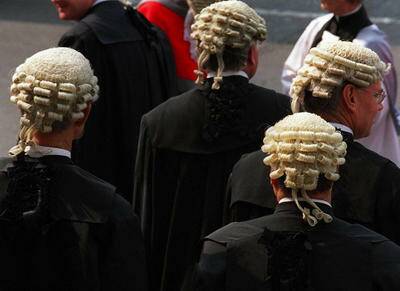
Nothing should surprise me in a country that invades another country, then has a parliamentary debate about it nine years later.But my flabber is gasted by the fact that some judicial figures in Australia continue to wear wigs.I'm surprised anyone clings to this outmoded relic of Britain's judicial fashionistas, what with the price of a decent horsehair weighing in at around $2500.If you sit in court as often as I do - as a reporter, not a defendant, thank you - you would surely wonder, too, how uncomfortable it must be to spend your working day weighed down by tons of wool, lace, silk and ermine in a panoply of wigs, hoods, robes, cummerbunds and jabots.I suppose it was all designed to invest those so attired with an aura of authority and greatness.But, in 2010, all it does is set them up as comical figures of fun, at least from where I sit.Modern judges and barristers, however, don't seem half as daft as society gentlemen of three or four centuries ago.Men such as the London diarist Samuel Pepys wore wigs by choice, at great cost, trouble and discomfort, and continued doing so for 150 years.Wigs were so valuable they were left often as bequests in wills.Their size came to denote one's place on society's totem pole - one could become a big wig, literally.I am indebted to American author Bill Bryson for the following observations on wigs in his new book At Home: to make wigs more bearable, many men shaved their heads, thus getting rid of their own perfectly comfortable hair and instead covering their heads with something foreign and uncomfortable;Often it was actually their own hair made into a wig;Those who couldn't afford wigs tried to make their hair look like a wig.Wigs took a lot of maintenance; once a week the curls had to be reshaped or "fluxed" on heated rollers;It became fashionable to powder them with a daily snowfall of flour, which was fine until the wheat harvests in France failed. This led to riots when starving millions realised the scarce flour supplies were being used not to bake bread but to powder the privileged heads of aristocrats.I can imagine Marie Antoinette declaring: "If they can't have bread, let us have wigs."When women got into the act, wigs interspersed with real hair got really silly, rising to monumental heights of half a metre and more.This required their owners to sleep with their necks on wooden blocks.At least two unfortunates died after their wigs caught fire in chandeliers.Fashion, it seems, often is designed to make people look not only as preposterous as possible, but as distressed as possible.Think platform shoes.If you have insufficient hair and want more, like Shane Warne and Doug "the rug" Bollinger, then a wig is the way to go.But even then there are attendant dangers.At a wedding I once attended (as the groom, in fact), an overzealous young guest whisked a matron backward over his bended knee in a dramatic dancing manoeuvre, then watched in horror as her wig flew across the floor.When wigs abruptly fell out of favour in the early 1800s, wigmakers unsuccessfully petitioned George III to make them compulsory.Soon they were being used as dust mops.And it is to this end that I commend the lingering vestiges of Australia's crop of judicial moptops.
Subscribe now for unlimited access.
$0/
(min cost $0)
or signup to continue reading

